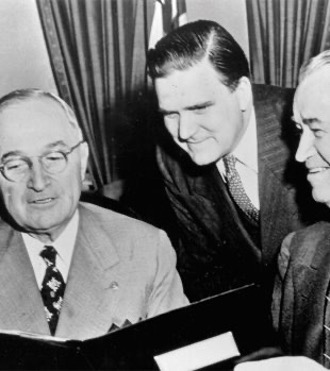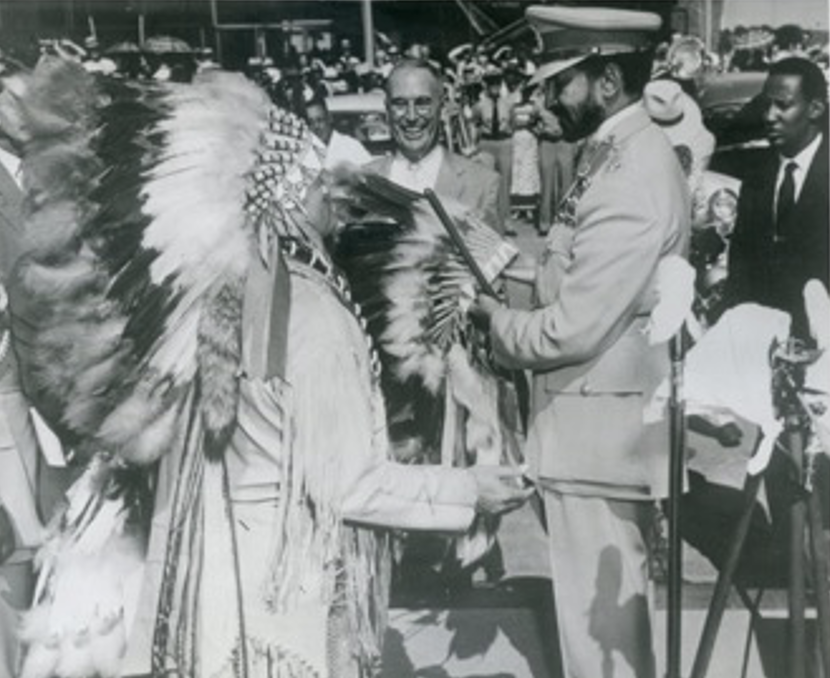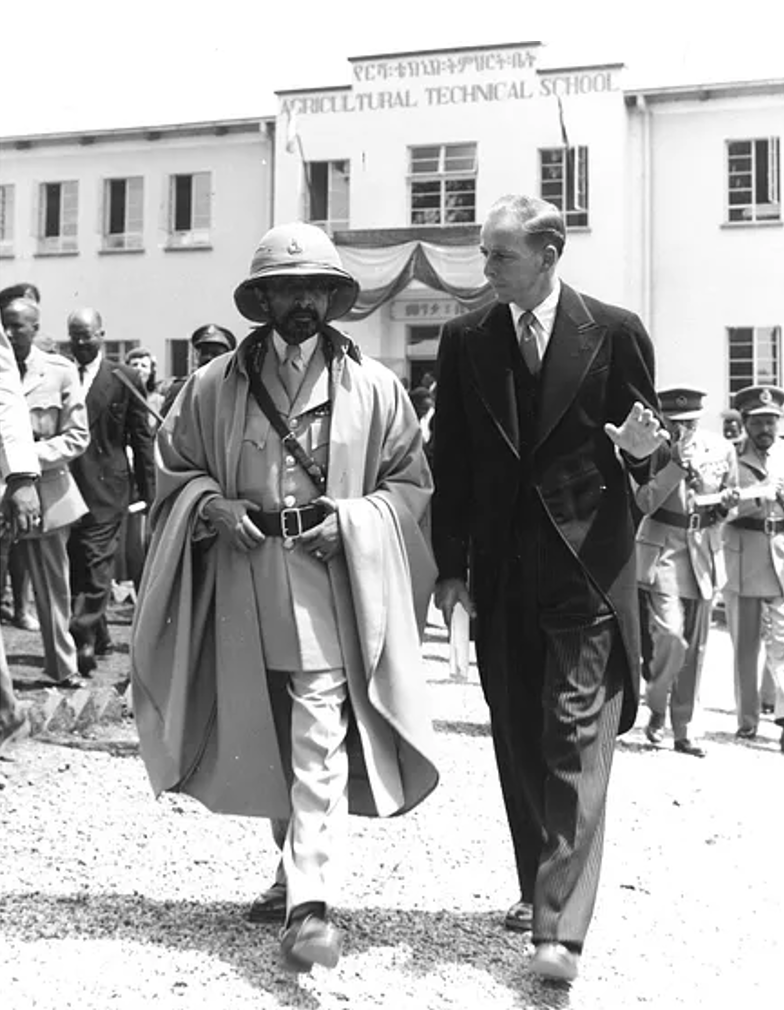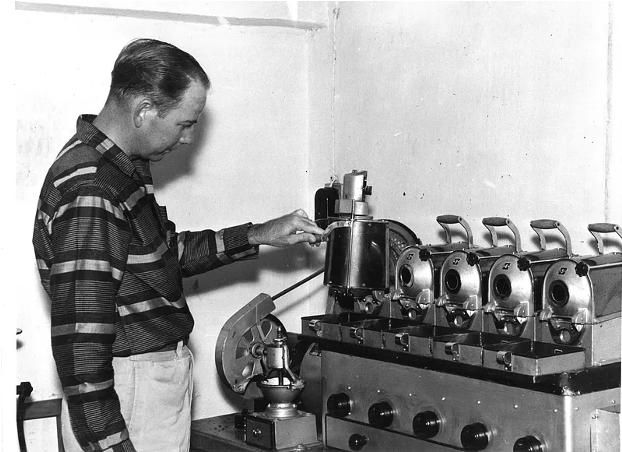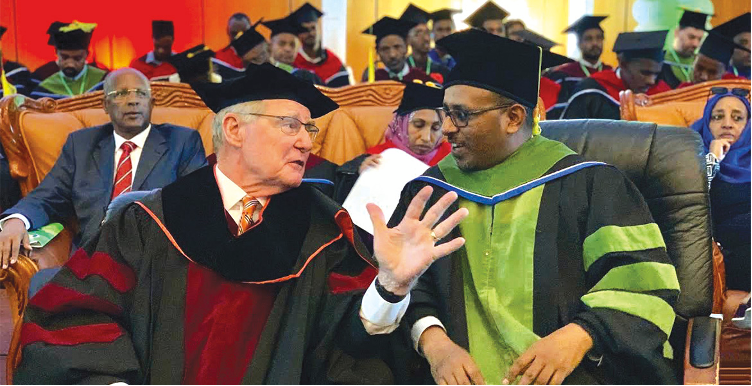A Global OSU
The Point Four Program
In the early 20th century, a number of land-grand college administrators realized the resources their institutions could provide for the growth of international technical assistance programs in emerging countries. OSU President, Henry G. Bennet was a leading advocate for this movement. He used his experience as president of an agricultural school with strong research and extension capabilities to provide assistance for countries dealing with food and agricultural production issues.
Oklahoma State University's role in education on the international level was a result of a political movement started by President Harry S. Truman in 1949. In his inaugural address, President Truman presented a strategy for sharing American knowledge and technology with emerging nations. This plan was the fourth major point of his address and led to the creation of the "Point Four" program in reference to his strategy.
Bennett spent the summer of 1949 traveling postwar Europe with the Civilian Agricultural department of the Army. He gathered information on food shortages following WWII and provided assistance and potential solutions. In 1950, Emperor Haile Selassie of Ethiopia requested Bennett's expertise on the possibility of establishing an agricultural college. After returning from Ethiopia, Bennett secured a meeting with President Truman in Washington D.C. in which he discussed his travels and beliefs in regards to educational assistance for developing countries. President Truman requested a report on Bennett's visit to Ethiopia and was so impressed with his philosophies on education that he appointed Bennett as Administrator of the Technical Cooperation Administration in November of 1950.
The role that Bennett played in developing the philosophy and logistics of the Point Four Program was instrumental. Over the years, he stressed that Point Four was a program about people helping people. Sadly, Bennet's career reached a tragic end in December 1951 while visiting Point Four programs in the Middle East and Africa when he, his wife and three assistants were killed in an airplane crash near Tehran, Iran.
As a result of Bennett's visit to Ethiopia in 1950 and his companionship with Emperor Haile Selassie, Ethiopia became the first country to request assistance through the Point four program, and an agreement was signed between Ethiopia and the United States on June 16, 1951. The contract was initiated by President Bennett and was granted to Ethiopia following his death. This was the beginning of a "great adventure" for Oklahoma State University as we continue to honor the legacy of Bennett and his philosophies and strive toward meaningful and impactful relationships with educational institutions around the world.
"The Point Four Program is education, from first to last. It is in fact the essence of education: an adventure in the sharing of knowledge; an adventure in which those who share their knowledge gain new insight and new experience."
- Henry G. Bennett, President of OSU from 1928-1951 and founder of OSU's Point 4 Program
Oklahoma State and Ethiopia
Under the Point Four Program, Oklahoma State University signed an agreement with the Imperial Ethiopian government and Emperor Haile Selassie to create Haramaya University and a secondary technical program, which became Jimma Technical School. In the early 1950s, after this agreement was signed, over 100 Oklahoma A&M faculty members, researchers and their families moved to Ethiopia, establishing the foundation for Jimma, Haramaya and the Debra Zeit agricultural research facility.
Through this relationship with Haramaya, OSU contributed to a number of agricultural developments in Ethiopia. The first OSU dean at Haramaya, Hugh Rouk, established the coffee research center. Their work helped to standardize harvest and post-harvest procedures, which improved the quality of Ethiopian coffee.
Changes in politics lessened the connection between OSU and Ethiopia. However, individual ties kept the relationship alive from the 1970s through the 2010s. OSU President Burns Hargis visited Haramaya University to celebrate the commencement of over 7,000 graduates in July 2019. Hargis was the second OSU president to deliver the commencement address to Haramaya students; the first was OSU President Oliver Willham who gave a speech to the first class of graduates in 1957.
"Oklahoma State is extremely proud of its long history with Ethiopia and its people. We are excited to work with Haramaya officials going forward."
- Burns Hargis, OSU President from 2008-2021
Laying the Groundwork for OSU Global
From 1899, when the first international student was enrolled to President Bennett's integral role in the development of the Point Four program, OSU has a long and prosperous history with the international education community. After the first project in Ethiopia, the remaining half of the 20th century saw the development of numerous other programs in countries such as Pakistan, Thailand, Egypt, Jordan, Japan and Kazakhstan among many others.
Throughout that time, OSU also continued international efforts on campus with the establishment of numerous departments and programs such as the English Language Institute in 1970 and the Study Abroad Office in 1996. In the mid-80s, the Center for International Trade Development was proposed based on the work of Oklahoma Third District Congressman, Wes Watkins, who sought the creation of an physical space that would allow for support and research regarding the development of international trade. After collecting the appropriate funds and drafting a formal proposal to the United States Department of Agriculture Cooperative State Research Services, groundbreaking for the new building occurred on April 22, 1988. The facility was completed in 1990 and officially named the Wes Watkins Center (WWC) in 1998. One year later, OSU celebrated the 50th Anniversary of the Point Four program with a dedication ceremony in 1999.
The Wes Watkins Center is still the home of OSU Global today. Located immediately northwest of Boone Pickens Stadium, WWC is the hub of international activity at OSU, housing the School of Global Studies academic program, the Center for Global Learning, the English Language and Intercultural Center, the Office of International Students and Scholars and the Wes Watkins Center for International Trade Development.
"The growth of international involvement for the Oklahoma State University campus can be attributed largely to outstanding leadership. That leadership always originated from university presidents with a worldview and personal interest in international educational affairs."
- Paul William Bass and Katie Sewell, authors of School of International Studies: A History of Leadership and Learning, 2016
Creation of the School of International Studies
In July of 1997, former OSU president Lawrence Boger began collaborating with then president James Halligan on the development of a plan to achieve international goals on campus, including the creation of a "School of International Studies." The idea was received favorably by the Dean's Council, and a draft for the new program was developed.
After approval from the University Committee and President Halligan, a proposal for the new program was presented to the Board of Regents. On July 24, 1998, the board authorized the creation of the School of International Studies, appointing Dr. James Hromas as the first dean. With support from the president, committees and faculty, it was decided that the Wes Watkins Center for International Trade Development would be the home of the new program, and on April 1, 1999, the formal dedication service was held.
Upon its creation, the School of International Studies absorbed relevant programs including the English Language Institute, the Study Abroad Office, Peace Corps Recruiting, Graduate Program and Outreach. On April 9, 2009, the School of International Studies celebrated 10 years of service and commitment with a special service attended by Congressman Watkins and other members of OSU's international community.
In the years following, the School of International Studies helped the development and expansion of the programs under its umbrella, particularly the Study Abroad Office, the English Language Institute, the Fulbright Program, the Mexico Liaison Offices and the Graduate Program, which revamped its curriculum and requirements in 2010 and 2011.
Oklahoma State University's future international endeavors were revisited in 2015 with the development of an International Strategic Plan. Priorities of the plan included increasing participation in study abroad and international internships, additional recruiting efforts, strategic partnerships, continuing to serve the international community in Oklahoma, the development of administrative structure, and increasing scholarship opportunities among other goals.
"The base of legacy, the past and present leadership, and the ongoing process of learning all give a positive picture looking into the future of the international studies experiences at Oklahoma State University."
- Paul William Bass and Katie Sewell, authors of School of International Studies: A History of Leadership and Learning, 2016
A Global OSU


